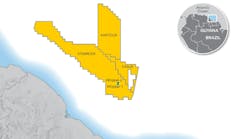Offshore staff
ABERDEEN, UK – Global deepwater capex is set to rise by 130% over the next five years, said Douglas-Westwood chairman John Westwood at the DOT International plenary session.
Total investments over this period would reach $260 billion, he added, with 82% directed at the “Golden Triangle” of theGulf of Mexico, Brazil, and West Africa.
Westwood also foresaw $99 billion of capex committed to floating production during the coming years, much of this indeepwater.
Deepwater production will continue to increase its percentage of the global energy mix, he predicted, although various concerns need to be addressed. One is that international oil companies now hold 80% of the world’s hydrocarbon reserves, “so the pressure is on them to move more into deepwater.”
Another problem is soaring costs. Global E&P investments are set to hit $700 billion this year, he said, adding that the scale of spending is causing some projects to be pulled back, or resurrected with a focus on major cost reductions.
The main reason costs have risen so much is that demand for products and services has exceeded supply, he explained, while there has also been “widespread over-engineering of projects, and the lack of an industrialized approach.” Another downside has been the increased emphasis onlocal content in some of the major deepwater provinces. “A locally qualified engineer in Brazil costs 50% more than bringing in an engineer from another country,” he suggested.
Craig May, managing director of Chevron Upstream Europe, said production from Chevron’s deepwater assets would almost double over the next few years, helped by contributions from big projects such as Jack/St. Malo and Bigfoot in the GoM and Lianzi off Angola.
However, delivering production from ever-deeper water is not easy, he pointed out, especially when drilling through unstable formations to the salt layer and then through rubble zones to deep-lying reservoirs. In some cases the reservoirs have low permeability and productivity, he added.
Some issues that Chevron is grappling with in deeper water are flow assurance, pressure, and power supply for longer-distance tiebacks, he said. “We must keep pushing technologies to address our challenges.
“Our focus includes improved subsea imaging, safer operations, and technology that helps to reduce the overall risk, i.e. monitoring integrity of wells and reducing the size and scope of facilities for drilling and production. All that helps to lessen the expense.”
May advocated dry tree semis as more efficient than wet tree systems for deepwater field development in the GoM. “Dry tree semis can increase recovery by up to 20% because the well costs are lower, so more wells can be drilled with tighter well spacings, and that also means fewer interventions.”
One technique that has paid off for Chevron in the GoM has been dual gradient drilling. “It effectively removes the riser, allowing you to drill a well on the seafloor as on land. Chevron is also using dual gradient technology for exploratory drilling – it means fewer casing runs, with larger casings at reservoir depth, giving us more completion options.”
Another of the company’s goals in deepwater is to optimize waterflooding, May said, particularly in the GoM. At the Tahiti field the company is injecting water through 15,000-psi trees. “With Lower Tertiary injection you can do this at even higher pressures.
“We have installed intelligent completions on subsea wells in Tahiti, and we want to do this next in Lower Tertiary reservoirs with higher pressures.”
10/14/2014




